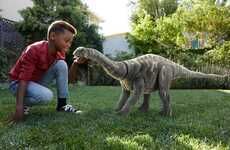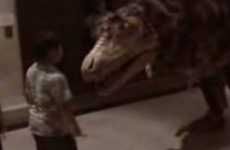
Tuatara Mates After 111 Years
The most fascinating beast being (trend) hunted today is the Tuatara, one of the world's last living dinosaurs. The particular tuatara fascinating the media is an 111 years old male expecting babies. Since the news broke, thousands of people have turned to the web in search of tuatara pictures!
Tuataras are part of the Sphenodontidae family, and the only remaining member of the Rhynochocephalia order (the rest roamed the earth about 200 million years ago.) They have been listed as endangered since 1895, but if all goes well, this dinosaur could be making a comeback! Henry the tuatara mated with a female tuatara, Mildred, at the Southland Museum and they are now waiting for about a dozen eggs to hatch.
The thing that seems to fascinate people most about the tuatura, besides the fact that it's having babies, is that the native New Zealand reptile has a third eye, or parietal eye. No, it's not an ogre-style eye in the middle, nor is it like a "spiritual eye," rather, it's a barely visible tiny eye on top of the head, usually hidden in the tuatara's wrinkled skin.
Random fact: Tuatura means "peaks on the back" in the MÄori language.
Tuataras are part of the Sphenodontidae family, and the only remaining member of the Rhynochocephalia order (the rest roamed the earth about 200 million years ago.) They have been listed as endangered since 1895, but if all goes well, this dinosaur could be making a comeback! Henry the tuatara mated with a female tuatara, Mildred, at the Southland Museum and they are now waiting for about a dozen eggs to hatch.
The thing that seems to fascinate people most about the tuatura, besides the fact that it's having babies, is that the native New Zealand reptile has a third eye, or parietal eye. No, it's not an ogre-style eye in the middle, nor is it like a "spiritual eye," rather, it's a barely visible tiny eye on top of the head, usually hidden in the tuatara's wrinkled skin.
Random fact: Tuatura means "peaks on the back" in the MÄori language.
Trend Themes
1. Endangered Species Conservation - There is a growing interest in conserving and protecting endangered species, such as the tuatara, to prevent their extinction.
2. Wildlife Tourism - The fascination with unique and rare animals, like the tuatara, has led to an increase in wildlife tourism and the exploration of exotic destinations.
3. Reptile Conservation - The successful breeding of the tuatara provides an opportunity for further research and development of conservation strategies for reptiles and other endangered species.
Industry Implications
1. Zoos and Wildlife Parks - Zoos and wildlife parks can capitalize on the public interest in rare animals, like the tuatara, by featuring them in exhibits and educational programs.
2. Eco-tourism - Eco-tourism companies can create unique experiences centered around observing and learning about endangered species, such as the tuatara, in their natural habitats.
3. Biotechnology and Genetics - The successful breeding of the tuatara opens up opportunities for biotechnology and genetic research focused on preserving and restoring endangered species.
2.6
Score
Popularity
Activity
Freshness























